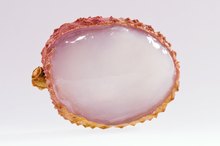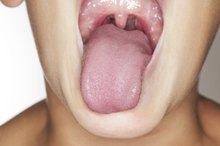Tart Cherry Juice Allergies
An allergy to tart cherry juice is an immune system reaction that may occur minutes or hours after drinking the juice. The allergic reaction can cause symptoms, including swelling, rash, itching, digestive problems or swollen mouth, tongue or airways. The highest cause for concern is the possibility of airway constriction during an acute allergy attack. This condition -- called anaphylaxis -- requires emergency medical treatment.
If you are experiencing serious medical symptoms, seek emergency treatment immediately.
Symptoms
A food allergy is sometimes difficult to pinpoint due to the varied nature of the symptoms. Signs and symptoms may include abdominal pain, diarrhea or vomiting. It is common to have asthma, wheezing, cough or itchy eyes, nose and throat. Sometimes the lips, mouth, tongue or face swells up. Rashes, redness on the skin or hives may also be visible. During an allergy attack, you may feel dizzy, confused or lightheaded.
- A food allergy is sometimes difficult to pinpoint due to the varied nature of the symptoms.
- Rashes, redness on the skin or hives may also be visible.
Prevalence
Can You Be Allergic to Passion Fruit?
Learn More
Many people with food allergies are allergic to more than one food or allergen. People who suffer from hay fever may also be sensitive to tart cherries or tart cherry juice because the allergy-causing protein in the two plants are similar. According to the Mayo Clinic, food allergies to tart cherry juice or other foods affect about 6 to 8 percent of children under age 5 and about 3 to 4 percent of adults.
Reaction
A reaction to tart cherries or tart cherry juice involves two main aspects of the immune system. One component is an allergy antibody called immunoglobulin E and the other is the mast cell, which stores up histamine.
Intolerance
Signs & Symptoms of Throat Allergies
Learn More
A food intolerance usually causes gastrointestinal problems, such as:
- bloating or gas
- but rarely produces cough
- runny nose
- itchy red eyes like an allergy
- according to the Mayo Clinic
Ask your doctor to perform a simple skin test in order to determine if you have an intolerance or an allergy. If an allergy is confirmed, the allergist may prescribe medications or a rescue inhaler.
Related Articles
References
- Pollen Library: Sour Cherry
- Cherry juice, tart. USDA FoodData Central. April 1, 2019
- Apple and cherry juice, pure, unsweetened. University of Sydney Glycemic Index Research Service. Updated November 26, 2019
- Kuehl KS, Perrier ET, Elliot DL, Chesnutt JC. Efficacy of tart cherry juice in reducing muscle pain during running: a randomized controlled trial. J Int Soc Sports Nutr. 2010 May 7;7:17. doi:10.1186/1550-2783-7-17
- Howatson G, McHugh MP, Hill JA, Brouner J, Jewell AP, van Someren KA, Shave RE, Howatson SA. Influence of tart cherry juice on indices of recovery following marathon running. Scand J Med Sci Sports. 2010 Dec;20(6):843-52. doi:10.1111/j.1600-0838.2009.01005.x
- Levers K, Dalton R, Galvan E, Goodenough C, O'Connor A, Simbo S, Barringer N, Mertens-Talcott SU, Rasmussen C, Greenwood M, Riechman S, Crouse S, Kreider RB. Effects of powdered Montmorency tart cherry supplementation on an acute bout of intense lower body strength exercise in resistance trained males. J Int Soc Sports Nutr. 2015 Nov 16;12:41. doi:10.1186/s12970-015-0102-y
- Levers K, Dalton R, Galvan E, et al. Powdered tart cherry supplementation demonstrates benefit on markers of catabolism and muscle soreness following an acute bout of intense lower body resistance exercise. J Int Soc Sports Nutr. 2014;11(Suppl 1):P31. Published 2014 Dec 1. doi:10.1186/1550-2783-11-S1-P31
- Traustadóttir T, Davies SS, Stock AA, et al. Tart cherry juice decreases oxidative stress in healthy older men and women. J Nutr. 2009;139(10):1896-1900. doi:10.3945/jn.109.111716
- Kelley DS, Adkins Y, Laugero KD. A review of the health benefits of cherries. Nutrients. 2018 Mar 17;10(3):368. doi: 10.3390/nu10030368
- Chai SC, Davis K, Zhang Z, Zha L, Kirschner KF. Effects of tart cherry juice on biomarkers of inflammation and oxidative stress in older adults. Nutrients. 2019;11(2):228. Published 2019 Jan 22. doi:10.3390/nu11020228
- Chai SC , Davis K , Wright RS , Kuczmarski MF , Zhang Z . Impact of tart cherry juice on systolic blood pressure and low-density lipoprotein cholesterol in older adults: a randomized controlled trial. Food Funct. 2018 Jun 20;9(6):3185-3194. doi:10.1039/c8fo00468d
- Lynn A, Mathew S, Moore CT, Russell J, Robinson E, Soumpasi V, Barker ME. Effect of a tart cherry juice supplement on arterial stiffness and inflammation in healthy adults: a randomised controlled trial. Plant Foods Hum Nutr. 2014 Jun;69(2):122-7. doi:10.1007/s11130-014-0409-x
- Pigeon WR, Carr M, Gorman C, Perlis ML. Effects of a tart cherry juice beverage on the sleep of older adults with insomnia: a pilot study. J Med Food. 2010;13(3):579-583. doi:10.1089/jmf.2009.0096
- Howatson G, Bell PG, Tallent J, Middleton B, McHugh MP, Ellis J. Effect of tart cherry juice (Prunus cerasus) on melatonin levels and enhanced sleep quality. Eur J Nutr. 2012 Dec;51(8):909-16. doi:10.1007/s00394-011-0263-7
- How Fat Affects Gout. Arthritis Foundation.
- Martin KR, Coles KM. Consumption of 100% tart cherry juice reduces serum urate in overweight and obese Adults. Curr Dev Nutr. 2019;3(5):nzz011. Published 2019 Feb 25. doi:10.1093/cdn/nzz011
- Chen PE, Liu CY, Chien WH, Chien CW, Tung TH. Effectiveness of cherries in reducing uric acid and gout: A systematic review. Evid Based Complement Alternat Med. 2019;2019:9896757. Published 2019 Dec 4. doi:10.1155/2019/9896757
- Pollen Food Allergy Syndrome. American College of Allergy, Asthma, and Immunology. Updated March 21, 2019
- I Swallowed A Cherry Pit! Are Stone Fruit Pits Poisonous? Poison Control. National Capitol Poison Center.
- What You Need to Know About Juice Safety. U.S. Food and Drug Administration. Updated 10/30/2017
Writer Bio
Assia M. Mortensen has over 12 years of experience as an editor and journalist, and has published hundreds of articles in magazines, newspapers and online at "The Santa Barbara Independent," "Frontiers Magazine," "805 Living Magazine," Huffingtonpost.com, LIVESTRONG.COM and many other outlets. Mortensen graduated from the University of California in Santa Cruz with a Bachelor of Arts in literature and creative writing.









